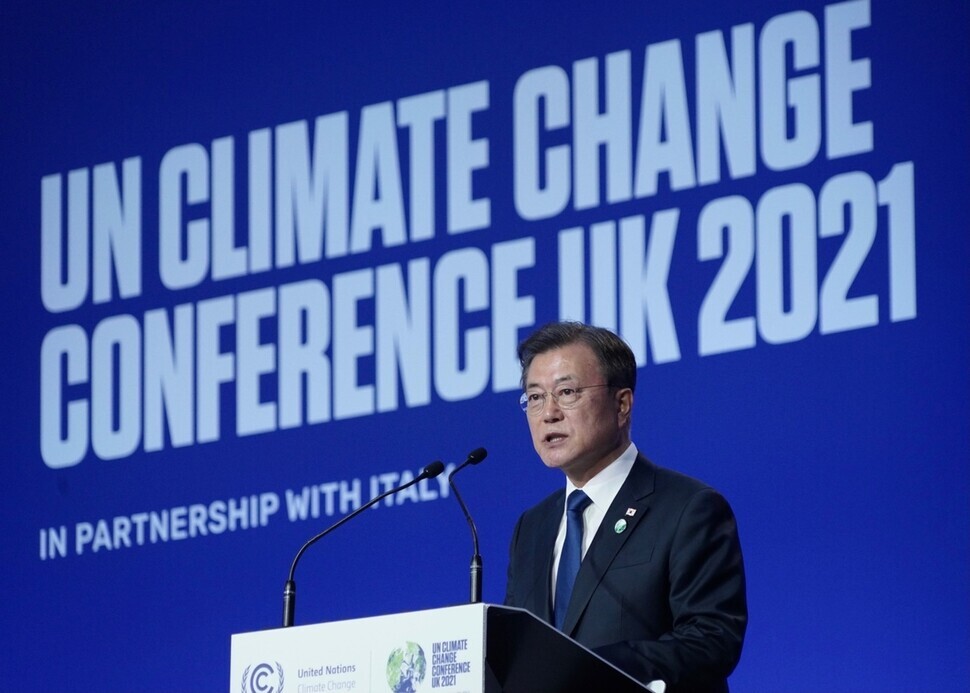hankyoreh
Links to other country sites 다른 나라 사이트 링크
Enforcing new, upgraded emission cuts would prevent worst effects of global warming, study finds

According to a recent report, if carbon emissions are reduced per the nationally determined contributions (NDCs) countries must submit by year's end, the probability of limiting the rise in average global temperatures to 2 degrees Celsius by the year 2100 grows to 34%.
An international research team that included Pacific Northwest National Laboratory (PNNL) of the US Department of Energy said on Thursday that if new or updated goals to reduce greenhouse gases are implemented, the world has a 34% chance of keeping the average temperature rise under 2 degrees by 2100 relative to preindustrial levels. This is significantly higher than the 8% probability projected under the initial reduction goals submitted in 2015.
This finding was reported in the team's research paper published in the latest edition of the scholarly journal Science.
The 2015 Paris Agreement established at the UN Climate Change Conference, COP21, requires signatories to the UN Framework Convention on Climate Change to submit NDCs on greenhouse gas emissions every five years. Countries must submit new reduction targets by the end of this year or renew their previous ones.
Korea's initial proposal in 2015 was a 37% reduction in emissions from the 2030 projection, but the plan underwent revisions. In 2019, the goal was cut to a 24.4% reduction relative to 2017 levels, inviting criticism for changing the calculation method but leaving the target intact. The proposal was submitted to the UN for the second time last year but was essentially rejected.
President Moon Jae-in on Monday announced a larger goal at the COP26 summit in Glasgow, Scotland. The plan for a 40% reduction by 2030 relative to 2018 levels will be officially in place soon.
The research team behind the report in Science analyzed the targets for greenhouse gas reductions of 121 countries submitted to the UN as of Sept. 30, with most of them being short-term cuts by 2025, 2030 and 2035.
New or updated goals under the Global Change Analysis Model were analyzed to reflect the economic impact of COVID-19, the sharp drop in solar cell prices, the spread of electric vehicles, and recent technological trends such as carbon capture and utilization technology.
If each country achieves its short-term goal and later sets and implements more ambitious ones, the team said, the probability of limiting the global temperature rise to under 2 degrees rises to 60%, while the possibility of limiting change to under 1.5 degrees grows to 11%.
The concept of "more ambitious goals," used by the research team refers to maintaining current reduction rates until 2030 and beyond, or in cases where this reduction rate stands at less than 2%, raising it to 2%.
Haewon McJeon, corresponding author of the paper and a research scientist at the Joint Global Change Research Institute, said that the upgraded goals must be implemented to achieve a positive long-term climate outlook.
McJeon wrote in the paper that “realizing the long-term climate benefits described in this study will require putting words into action by implementing these newer and enhanced targets. This could entail substantial political, financial, institutional, social, and behavioral challenges.”
He added, “Surmounting these challenges with policies and measures and successfully achieving the targets would substantially reduce global climate risks, essentially avoiding the worst outcomes from climate change and substantially improving the probability of limiting global warming to below 2 degrees Celsius.”
By Lee Keun-young, senior staff writer
Please direct questions or comments to [english@hani.co.kr]

Editorial・opinion
![[Column] Season 2 of special prosecutor probe may be coming to Korea soon [Column] Season 2 of special prosecutor probe may be coming to Korea soon](https://flexible.img.hani.co.kr/flexible/normal/500/300/imgdb/original/2024/0426/3317141030699447.jpg) [Column] Season 2 of special prosecutor probe may be coming to Korea soon
[Column] Season 2 of special prosecutor probe may be coming to Korea soon![[Column] Park Geun-hye déjà vu in Yoon Suk-yeol [Column] Park Geun-hye déjà vu in Yoon Suk-yeol](https://flexible.img.hani.co.kr/flexible/normal/500/300/imgdb/original/2024/0424/651713945113788.jpg) [Column] Park Geun-hye déjà vu in Yoon Suk-yeol
[Column] Park Geun-hye déjà vu in Yoon Suk-yeol- [Editorial] New weight of N. Korea’s nuclear threats makes dialogue all the more urgent
- [Guest essay] The real reason Korea’s new right wants to dub Rhee a founding father
- [Column] ‘Choson’: Is it time we start referring to N. Korea in its own terms?
- [Editorial] Japan’s rewriting of history with Korea has gone too far
- [Column] The president’s questionable capacity for dialogue
- [Column] Are chaebol firms just pizza pies for families to divvy up as they please?
- [Column] Has Korea, too, crossed the Rubicon on China?
- [Correspondent’s column] In Japan’s alliance with US, echoes of its past alliances with UK
Most viewed articles
- 1AI is catching up with humans at a ‘shocking’ rate
- 2Korea’s 1.3% growth in Q1 signals ‘textbook’ return to growth, says government
- 3[Column] Park Geun-hye déjà vu in Yoon Suk-yeol
- 4[Column] Season 2 of special prosecutor probe may be coming to Korea soon
- 5No good, very bad game for Korea puts it out of Olympics for first time since 1988
- 6Marriages nosedived 40% over last 10 years in Korea, a factor in low birth rate
- 7Division commander ordered troops to enter raging flood waters before Marine died, survivor says
- 81 in 5 unwed Korean women want child-free life, study shows
- 9[Column] Has Korea, too, crossed the Rubicon on China?
- 10Will NewJeans end up collateral damage in internal feud at K-pop juggernaut Hybe?